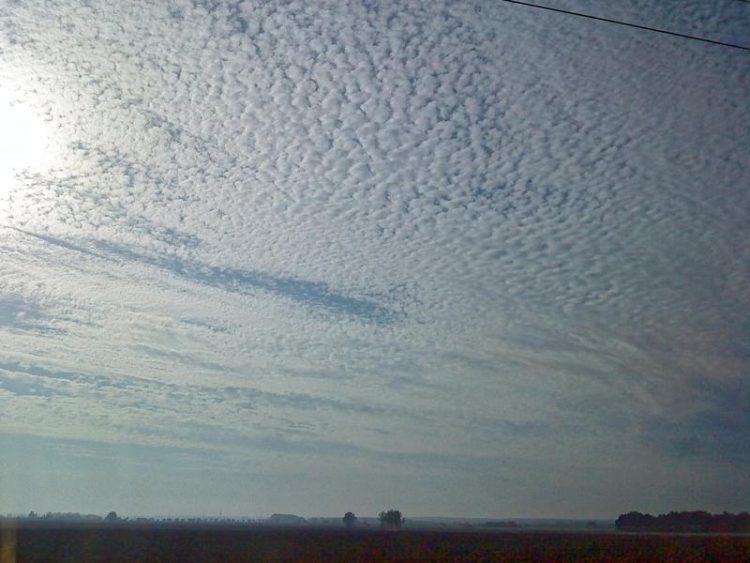Turbulence creates ice in clouds

The results from Leipzig could help to map an important part of the water cycle better in the weather and climate models in the future by ice formation in clouds.
The formation of ice in clouds is a core element of the water cycle on Earth. It is usually difficult to isolate the ice formation process in order to study it individually because the interaction of aerosol particles, air motion and microphysical processes in clouds is too complex. Nevertheless, it is necessary to understand these processes in detail in order to better map this mechanism in weather and climate models.
The cloud researchers concentrated on a less spectacular and therefore less considered form of clouds in order to exclude other processes than primary ice formation. They investigated large cloud fields at an altitude of about 2 to 8 kilometres with a vertical extent of only 100 to 200 metres and contained extremely little ice in the range of micrograms per cubic meter.
Such thin cloudsallow both ice to be detected with a cloud radar and the vertical air movement with a Doppler lidar, as the laser beam can still penetrate the clouds. Both lidar and radar instruments were therefore necessary to investigate the turbulence and ice formation in these clouds above Leipzig from the ground.
“The effect only became visible when we observed the ice directly below the clouds’ top layer. Our findings enable for the first time quantitative and well constraint insights into the relationship between turbulence and ice formation in the atmosphere. The stronger a cloud is 'shaken' by vertical air motions, the more ice falls out of it,” reports Dr Johannes Bühl of TROPOS.
This correlation was measured for clouds colder than -12 °C. Next, the remote sensing scientists want to explore the influence of aerosols by taking a closer look at the beginning (ice nucleation) and end (precipitation of ice particles) of the ice formation process.
Ice formation in clouds is an important process in the atmosphere, because without this ice practically no precipitation would fall from clouds in the middle latitudes of the Earth. As far-reaching as these processes may be, many details have not yet been sufficiently understood and are therefore not taken into account in the weather and climate models. Tilo Arnhold
Links:
The Leipzig Aerosol and Cloud Remote Observations System LACROS
https://www.tropos.de/en/research/projects-infrastructures-technology/coordinate…
Current data from LACROS:
http://lacros.rsd.tropos.de/
CLOUDNET:
https://www.tropos.de/en/research/projects-infrastructures-technology/coordinate…
Contacts:
Dr Johannes Bühl, Dr Patric Seifert, Dr Ronny Engelmann
Scientific staff, Department „Remote Sensing of Atmospheric Processes“ at the Leibniz Institute for Tropospheric Research (TROPOS), Leipzig, Germany
Phone +49-341-2717-7312, -7080, -7315
https://www.tropos.de/en/institute/about-us/employees/johannes-buehl
https://www.tropos.de/en/institute/about-us/employees/patric-seifert
https://www.tropos.de/en/institute/about-us/employees/ronny-engelmann
and
Dr Albert Ansmann
Leader of the Working Group Ground Based Remote Sensing, Department „Remote Sensing of Atmospheric Processes“ at the Leibniz Institute for Tropospheric Research (TROPOS), Leipzig, Germany
Phone: +49-341-2717-7064
https://www.tropos.de/en/institute/about-us/employees/albert-ansmann
or
Tilo Arnhold
Public Relations at the Leibniz Institute for Tropospheric Research (TROPOS), Leipzig, Germany
Phone: +49-341-2717-7189
https://www.tropos.de/en/current-issues/press-releases
Bühl, Johannes; Seifert, Patric; Engelmann, Ronny and Ansmann, Albert (2019): Impact of vertical air motions on ice formation rate in mixed-phase cloud layers. npj Climate and Atmospheric Science volume 2, Article number: 36 (2019). DOI: 10.1038/s41612-019-0092-6.
https://doi.org/10.1038/s41612-019-0092-6
The study was funded by the European Union under the Seventh Framework Programme (ACTRIS / 262254 and BACCHUS / 603445) and the German Research Foundation (DFG; UNDINE / 162311106).
https://www.tropos.de/en/current-issues/press-releases/details/turbulenz-sorgt-f…
Media Contact
All latest news from the category: Earth Sciences
Earth Sciences (also referred to as Geosciences), which deals with basic issues surrounding our planet, plays a vital role in the area of energy and raw materials supply.
Earth Sciences comprises subjects such as geology, geography, geological informatics, paleontology, mineralogy, petrography, crystallography, geophysics, geodesy, glaciology, cartography, photogrammetry, meteorology and seismology, early-warning systems, earthquake research and polar research.
Newest articles

Properties of new materials for microchips
… can now be measured well. Reseachers of Delft University of Technology demonstrated measuring performance properties of ultrathin silicon membranes. Making ever smaller and more powerful chips requires new ultrathin…

Floating solar’s potential
… to support sustainable development by addressing climate, water, and energy goals holistically. A new study published this week in Nature Energy raises the potential for floating solar photovoltaics (FPV)…

Skyrmions move at record speeds
… a step towards the computing of the future. An international research team led by scientists from the CNRS1 has discovered that the magnetic nanobubbles2 known as skyrmions can be…




















